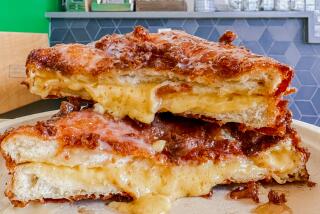EASTER : The Incredible, Edible Symbol
- Share via
“When Yule comes, dole comes,
Cold feet and legs;
When Easter comes, grace comes,
Butter, milk and eggs.”
--An old Easter rhyme
*
When eggs start appearing in coats of many colors and children come home from school with dainty, grass-filled baskets, we don’t have to look at our calendars to know that it’s Easter once again. For eggs are a symbol of Easter, or to put it another way, it wouldn’t feel quite like Easter if there weren’t any brightly colored eggs about it.
The association of Easter with eggs is one we nowadays take for granted, but the connection has intrigued many folklorists. What is it about the egg that makes it such an ideal symbol of this particular holiday?
Imagine for a moment the utter amazement of Stone Age man when he first saw a little chick peep out of a just-hatched egg. After observing life emerge from an apparently inanimate object, primitive people must have imputed the egg with magical powers. As a result, countless creation myths describe how the universe emerged from an enormous cosmic egg.
*
Because of its life-giving properties, the egg naturally became a symbol of continuing life. The people of ancient Egypt, China, Greece and Persia incorporated eggs into their spring and harvest festivals, both celebrations of the renewed life evident in nature at those times. And as recently as 100 years ago, Estonians ate eggs while plowing and Scots placed an egg at the bottom of their sowing basket to insure a good harvest.
The egg’s power to bring forth new life made it a natural symbol of Christ’s Resurrection, and in the early years of Christianity, parishioners were invited to bring eggs to church to be blessed during the Easter season. These special eggs were then exchanged as gifts. In Poland, the eggs were traditionally painted red, blue and green, a reminder of the legend that Mary decorated eggs with these colors to amuse the baby Jesus.
But the tradition of coloring eggs began long before the Christian era. Because the life that emerged from the egg was always such a mystery to early man, he was never certain whether good or evil would be released when the egg cracked open. It was in an attempt to control the outcome that man began to say charms over eggs, paint signs and symbols with positive connotations on them or dye them bright red--a color he associated with good luck.
Because the methods and fashions of egg decorating developed independently from one country to the next, the final products have always varied noticeably. Originally, there was a strong tradition of dyeing eggs a solid, bright red, but gradually techniques evolved for painting intricate geometric designs and diminutive paintings on the eggs, particularly in the Ukraine and in Russia.
*
In the Ukraine, even the humblest peasant women learned to decorate eggs around Easter time, and almost every family had its own designs and secret methods for making its own dyes. After receiving the Easter blessing, the colorful pysanky (as the Ukrainian eggs are called) were prominently displayed in every home as a protection against lightning and fire.
The Pennsylvania Dutch have an unusual way of displaying their brightly colored eggs. Following a tradition brought with them from Germany, they arrange bare branches in a large vase and hang the eggs by strings from the branches.
Of course, many amusing games are associated with the Easter egg. One game, played all over Europe, involves a hare, the sacred beast of Easter, the Saxon goddess of spring whose name has probably given us the word Easter. According to tradition, the hare (in America, the rabbit) hides Easter eggs all around the house and the children must find them. “Finders, keepers” is the order of the day, and the best sleuth’s reward is the greatest number of beautifully decorated eggs.


